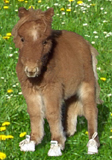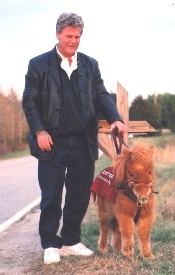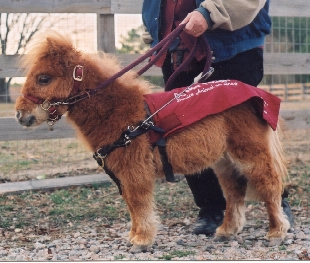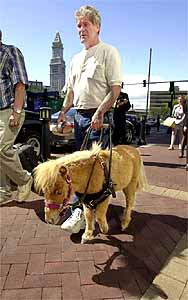|
|
The Guide Horse
Foundation A non-profit charity dedicated to providing free guides for visually impaired individuals. |
 |
|
Frequently Asked Training Questions This is a list of the most frequently asked questions about the training of Guide Horses. If your question is not on this list, please feel free to e-mail us with your question. How smart are horses? While horses do not possess complex reasoning skills, miniature horses are quite intelligent and excel at tasks that require long-term memory skills. There is been a great deal of research into the cognitive psychology of horses, most notably by Dr. Evelyn Hanggi of the Equine Research Foundation of Horse Learning and Behavior. Dr. Hanggi has done extensive clinical research on horse intelligence and is most noted for proving the theorem that a horses ability to learn is directly proportional to their prior learning. In other words, the more a horse learns, the greater their capacity for future learning. Noted animal learning expert, Professor Emeritus Frank A. Logan also provides comments regarding horse learning. All Guide Horse candidates must pass a field intelligence test prior to acceptance into the Guide Horse program.
Can Guide Horses be taught to fetch and retrieve? With proper training a horse can be taught to do almost anything. The famous Arabian Dervish was taught to sit, lie down, pull up a blanket, turn out the light and go to sleep. Dervish appeared on the NBC Tonight Show to demonstrate his skills. Jay Evans, an Arabian Horse trainer, has trained a retrieving Arabian Stallion named Namoniet to catch a Frisbee with great success. Jay is still working on getting Namoniet to throw the Frisbee.
Can Guide Horses ride in vehicles? Yes. All Guide Horses are trained to ride in passenger vehicles, and some are trained to enter taxi cabs, busses and subway trains. Is it easy to train a Guide Horse? Guide Horse training is one of the most demanding equine disciplines and always requires an experienced professional horse trainer. To be absolutely safe, Guide Horses are trained at the same achievement level as an advanced dressage horse or a Lippazaner show horse. Because this advanced training requires significant experience, only full-time professional horse trainers are used in the Guide Horse training process. More important, the students must be able to entrust their lives to their Guide Horse, and only a professional horse trainer can certify that a Guide Horse is able to safely guide a blind person. Can a blind child use a Guide Horse? A visually disabled person over the age of sixteen can be taught to use and care for a Guide Horse. Younger children are not accepted for training as the person must be able to assume responsibility for the horse's care and discipline. How do you train a Guide Horse to guide the blind? While no formal documentation exists for training guide horses, our trainers use horse training methods and techniques from a variety of sources. Some techniques are borrowed from John Lyons, a world-renowned horse trainer. John Lyons offers a complete library of books and training tapes that illustrate how to teach a horse to willingly perform almost any task. John Lyons' training materials are available at his Web site: http://www.johnlyons.com. The trainers also rely on the basic principles of operant conditioning, and apply the animal training concepts originally described by B. F. Skinner, the famous behavioral psychologist. Are Guide Horses suitable for apartment dwellers? A Guide Horse can be trained to live in an apartment, but they prefer to live outdoors when off-duty. The ideal Guide Horse owner would have a fenced back yard with a lawn for grazing. Can Guide Horses live outdoors? Horse are natural outdoor animals and grow a soft wooly coat each fall to protect them against the winter chill. They can be kept outdoors in temperatures as low as 20 degrees Fahrenheit. Many horses prefer to have shelter in inclement weather. How long does it take to train a Guide Horse? Guide Horse Training normally takes approximately 6 months to one year and involves hundreds of hours of individualized training. When can a horse begin training? A young horse can start Guide Horse training after weaning, generally around six months of age. Can a Guide Horse use public transportation? Yes. The American’s with Disabilities Act guarantees the right of any service animal to use public transportation. With proper training, a Guide Horse can be trained to enter taxis, busses and subways. Can a Guide Horse use escalators and elevators? Yes. Part of the basic training for all Guide Horses includes elevator and escalator training. However. A Guide horse is trained to choose a ramp instead of using an escalator or stairs wherever possible. Are Guide Horses compatible with cats and dogs? A Guide Horse is very compatible with house pets. During their training, a Guide Horse shares common areas with cats and dogs and they learn to get along quite well. However, unsupervised large dogs are a serious threat to Guide Horses. Dogs are predators by nature, and a large dog should never be left alone with a Guide Horse. Can a Guide Horse be trained to stay home without a fence? A Guide Horse will have a natural desire to stay with their herd. In a Guide situation, the horse bonds with the blind owner as a herd member, and it will be very reluctant to wander away. The danger with an un-fenced area is the possibility of a predatory stray dog injuring the Guide Horse. It is never acceptable to leave a Guide Horse in an un-fenced area. Are Guide Horses suitable for city life? At the dawn of the twentieth century, New York City was the home of more than two million horses. Horses can adapt to almost any circumstances, but the ideal Guide Horse owner will live in a suburban or rural setting. How do you train a Guide horse not to "spook"? The Guide Horse Foundation uses the same techniques that have been employed for centuries in training Cavalry horses to remain calm, even in the heat of battle. The GHF also borrows techniques used by police departments in their training of riot control horses. The Guide Horses are systematically desensitized to chaotic and noisy situations and they are trained to ignore threats from other animals when in harness. Horses also look to their leader to know how to respond to a novel event. In the horse industry this is known as the "lead mare syndrome". In a herd, all horses look to the lead mare to see how she reacts to a new event. If the lead mare does not exhibit fear, all of the horses will relax. This principle applies to Guide Horse training, and the Guide Horse will not exhibit fear if their trainer is not scared. A Guide Horse is required to "spook in-place" even when surrounded by chaos, and all Guide Horses must pass a test before being certified to guide the blind. Do Guide Horses develop an attachment for their handlers? During training the Guide Horse will develop an almost symbiotic relationship with their handler. The Guide Horse will anticipate the desires of the handler and it will appear to spectators that the horse somehow senses the desires of the handler before the command is issued. One of the primary goals of the on-site training is to teach the blind handler to use a guide and then to bond with their horse and act as a team. Why do Guide Horses sometimes wear sneakers? Because of their hard hooves, a Guide Horse can slip on slick surfaces such as hardwood floors and waxed floors of stores and shopping malls. Just as guide dogs wear shoes to provide their paws from abrasion, hot pavement, rocks and glass, the Guide Horse may also wear shoes. Where do you get the tiny sneakers? There are several commercial manufacturers of tiny horse sneakers. The first is Sabre Sneakers, who has graciously offered to donate the sneakers for the Guide Horse program. Sabre Sneakers can be reached at (203) 322-9002. The other major manufacturer of tiny horse sneakers is Supreme Equine Designs. They can be reached at (800) 447-6053. How much does it cost to feed a Guide Horse? Grass is the natural food for a horse. A Guide Horse will eat approximately one bale of hay each week, for a cost of about four dollars. In addition, the horse is supplemented with a daily soup-can ration of oats that costs about 25 cents. For those with lawns, the hay will only be required during the winter months. Costs will vary with location. A veterinarian should be consulted to determine the exact nutritional needs of each individual horse. Does a Guide Horse respond to voice commands? Yes. The basic training of the Guide Horse includes learning 23 voice commands. Can Guide Horses be trained to pull a wheelchair? Yes. The Guide Horse Foundation has conducted preliminary studies of using a larger horses to pull a wheelchair. However, the horses selected for the Guide Horse program are too small for be used helping the physically disabled, and the Guide Horse Foundation is presently only training horses to aid the visually impaired. Can children ride a Guide Horse? No. Guide Horses are too small to be ridden. Can Guide Horses be housebroken? Yes. A Guide Horse can be housebroken. When they need relief, the horses are trained to paw at the door or make nickering noises. After indoor training, the Guide Horse can be relied upon not to have accidents. Horses that fail the housebreaking lessons are removed from the program. Why don't you call them seeing eye horses? The Seeing Eye is a registered trademark of The Seeing Eye, Inc. The Guide Horse Foundation is not affiliated with the Seeing Eye, but has great respect for their wonderful work with the visually impaired. Can Guide Horses go into public places? The Americans with Disabilities Act defines a service animal as any animal that assists the disabled, and it is against Federal law to refuse admittance to any properly trained service animal in a public place, including restaurants, stores and public transportation. Landlords are also prohibited from discriminating against a person with an assistance animal, and miniature horses acting as service animals are exempt from all local, County and State animal restrictions. Service animals may only be denied entrance if they pose a risk to safety or health or if they disrupt the business. Click here for details on the American with Disabilities Act as it applies to Guide animals. Does the blind person own their Guide Horse? The handler has the right to use the horse's service for life. The Guide Horse Foundation does reserve the right to take the horse back under extreme circumstances. We would only do so if the horse were being abused, neglected, exploited or endangered in any way, or if the horse were being used in a way that placed the handler at risk. If the handler's lifestyle or capability changes in such a way to prohibit continued use of the horse as a Guide we would assess the individual circumstances and the relationship between handler and horse as well as the wishes of the handler, before determining whether or not to retrieve the horse to serve a new handler. If the handler does not want to keep the horse for any reason, The Guide Horse Foundation will take the horse back. When the horse is retired the handler has the option of keeping it as a companion or returning it to the foundation for retirement. The handler does not have the right to sell the Guide horse under any circumstances. Does the Guide Horse have to be used frequently? One of the benefits to a Guide horse is that it does not have to be used daily to stay trained. The handler could use the horse when necessary and allow it to graze in peace when not needed. After a handler has been approved to pair with a Guide horse, we do not require a specific amount of use of the Guide horse. During the selection process we do try to approve applicants that we believe will get the most benefit from the service of a Guide horse. Is it hard to give-up your horses when they are delivered? When you work closely with an animal for hundreds of hours it is impossible not to get attached to the horses. However, we have the reassurance that each horse is going to a loving and committed home, and our on-site training of the student's ensures that they understand how to care for their horse. We also provide follow-up visits, so we get to visit them from time to time. What do like best about training Guide Horses? We especially like the enthusiasm of our students and seeing first-hand how their Guide Horses give them freedom and brighten their lives. We are also happy and honored to be a part of the re-introduction of horses into human society, and we are thrilled to see horses once again helping mankind travel further and faster than before. What television shows, newspapers, and magazines have you appeared in? We have appeared on ABC 20/20, Ripley's Believe It or Not! The Fox News Network, CNN, ABC News, NBC News, CBS News, Pet Project, Amazing Animals, Discovery Science News, Das Explosive (German TV), The Today Show, To Tell the Truth, Time magazine, People Magazine, The National Enquirer, National Examiner, Sunday Mail, the London Daily Mirror, the Boston Globe, New York Times, Cary News, Henderson Daily Dispatch, Atlanta Constitution, CBS Radio, Bangor Daily News and many others. More information is available at http://www.guidehorse.com/press.htm Are Guide Horses trained to protect their handlers? No, aggression is considered undesirable in any guide animal. It is a common misconception that Guide Dogs are trained to protect their handlers. In practice, all guide animals are trained to remain passive, and it is never proper for a guide animal to display aggression, even when threatened. The American's with Disabilities Act specifically allows for aggressive service animals to be excluded from public places if they demonstrate aggressive or dangerous actions such as growling, snarling, barking or biting. How did you learn to train guide animals? It was never the intent of Don and Janet Burleson to become guide trainers. After completion of their feasibility study in 1999, they were overwhelmed with requests from blind horse lovers, asking for a trained Guide Horse. Although she was confident in her skills as a retired professional horse trainer, Janet Burleson needed to learn what a guide animal needed to know to keep their handler safe. Even though horse training is vastly different from dog training, the Guide Horse Foundation worked closely with guide dog trainers, orientation and mobility specialists and experienced guide dog users to understand what a guide animal needs to know to keep their handler safe at all times. The Guide Horse Foundation also performed exhaustive research, studying all available training methods and techniques from the major guide dog training schools throughout the world.
Is your question not on this list? Please send us an e-mail and we will be happy to respond to your question.
|
Guides Training Press Photos News Apply FAQ Volunteers Wishes Contact Home
Copyright © 1998, 1999, 2000, 2001, by the Guide Horse Foundation Inc.
Guide Horse ® is a registered trademark of the Guide Horse Foundation Inc.
The Guide Horse Foundation has the utmost respect for The Seeing Eye® and their seventy-two years of outstanding work with assistance animals for the blind. Please note that The Guide Horse Foundation is not affiliated with or sanctioned by the Seeing-Eye® or any of the Guide Dog training organizations. Seeing-Eye® is a registered trademark of the Seeing-Eye, Inc.
APRO CRM . best denver chiropractor












